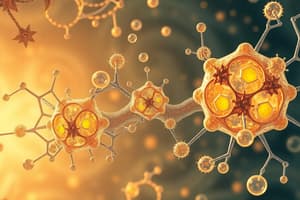Podcast
Questions and Answers
What is the role of enzymes in biochemical reactions?
What is the role of enzymes in biochemical reactions?
- They increase the free energy of the substrate.
- They act as substrates in reactions.
- They slow down the reaction rates.
- They act as catalysts to speed up reaction rates. (correct)
In a reaction coordinate diagram, what does the X-axis represent?
In a reaction coordinate diagram, what does the X-axis represent?
- The free energy of the substrate.
- The progress of the reaction. (correct)
- The rate of the reaction.
- The amount of product formed.
What does a negative ΔG indicate about a reaction?
What does a negative ΔG indicate about a reaction?
- The product has higher energy than the substrate.
- The reaction occurs spontaneously. (correct)
- The reaction is not feasible.
- The reaction is endergonic.
What does the activation energy represent in a reaction?
What does the activation energy represent in a reaction?
What is the purpose of the transition state in a reaction?
What is the purpose of the transition state in a reaction?
What does Gibbs free energy relate to in biochemical reactions?
What does Gibbs free energy relate to in biochemical reactions?
Which of the following statements is true regarding the stability of products and substrates?
Which of the following statements is true regarding the stability of products and substrates?
How does an enzyme affect the activation energy of a reaction?
How does an enzyme affect the activation energy of a reaction?
What does the y-intercept of the Lineweaver-Burke plot represent?
What does the y-intercept of the Lineweaver-Burke plot represent?
Which process would cause the Lineweaver-Burke plot to slope lower than the control?
Which process would cause the Lineweaver-Burke plot to slope lower than the control?
What does the x-intercept of the Lineweaver-Burke plot indicate?
What does the x-intercept of the Lineweaver-Burke plot indicate?
In the context of a Lineweaver-Burke plot, what is the relationship between Vmax and the slope of the line when upregulation occurs?
In the context of a Lineweaver-Burke plot, what is the relationship between Vmax and the slope of the line when upregulation occurs?
When substrate concentration increases, what happens to the initial speed of the reaction (V0) according to the Michaelis-Menten equation?
When substrate concentration increases, what happens to the initial speed of the reaction (V0) according to the Michaelis-Menten equation?
How does repression affect the Lineweaver-Burke plot?
How does repression affect the Lineweaver-Burke plot?
Which equation corresponds to the transformation of the Michaelis-Menten equation to create the Lineweaver-Burke plot?
Which equation corresponds to the transformation of the Michaelis-Menten equation to create the Lineweaver-Burke plot?
What effect does increased substrate concentration have on the Lineweaver-Burke plot?
What effect does increased substrate concentration have on the Lineweaver-Burke plot?
What role do enzymes play in biochemical reactions?
What role do enzymes play in biochemical reactions?
What is Vmax a measure of in enzyme kinetics?
What is Vmax a measure of in enzyme kinetics?
How does a low Km value affect enzyme function?
How does a low Km value affect enzyme function?
What impact does non-competitive inhibition have on Vmax?
What impact does non-competitive inhibition have on Vmax?
What happens to the reaction rate when all active sites on an enzyme are saturated?
What happens to the reaction rate when all active sites on an enzyme are saturated?
What is the effect of adding an activator to an enzyme?
What is the effect of adding an activator to an enzyme?
How does competitive inhibition alter the Km of an enzyme?
How does competitive inhibition alter the Km of an enzyme?
What is the function of the active site on an enzyme?
What is the function of the active site on an enzyme?
What does enzyme kinetics describe?
What does enzyme kinetics describe?
What is the consequence of an enzyme being denatured?
What is the consequence of an enzyme being denatured?
What is meant by up-regulation of an enzyme?
What is meant by up-regulation of an enzyme?
What does phosphorylation do to an enzyme?
What does phosphorylation do to an enzyme?
What is Km an indicator of in terms of enzyme functionality?
What is Km an indicator of in terms of enzyme functionality?
Flashcards are hidden until you start studying
Study Notes
Enzyme Function and Reaction Dynamics
- Substrates can revert to the transition state if sufficient activation energy is reached, but products require even more energy to revert back.
- Enzymes speed up reactions by stabilizing the transition state, effectively reducing the energy barrier.
- Enzymes are specialized proteins with an active site where substrates bind, forming an enzyme-substrate complex.
Analogy of Enzyme Action
- An analogy involves a nervous child getting vaccinated, representing substrates, where the vaccination represents products and the anxious transition state is the needle insertion.
- Enzymes function like calming adults who help decrease the energy of the transition state.
Properties of Enzymes
- Enzymes are not consumed in reactions; they can repeatedly bind to new substrates after releasing products.
- Each enzyme is specific to particular substrates, e.g., amylase breaks down carbohydrates in saliva.
Enzyme Kinetics
- Enzyme kinetics evaluates the rate of biochemical reactions, often represented by the Michaelis-Menten graph.
- X-axis: Concentration of substrate ([S]); Y-axis: Reaction velocity (V), indicating product formation over time.
- Reaction velocity increases with substrate concentration until all active sites are saturated, reaching maximum velocity (Vmax).
Michaelis Constant (Km)
- Km represents the substrate concentration needed for the reaction speed to be half of Vmax.
- A low Km indicates high enzyme affinity, while a high Km signifies low affinity.
Influences on Vmax and Km
- Vmax can change with enzyme quantity; increasing enzyme concentration raises Vmax, while gene expression induction can enhance enzyme levels.
- Repression of gene expression or down-regulation affects enzyme levels, reducing Vmax.
Inhibition Effects
- Non-competitive inhibition decreases Vmax by binding to the enzyme at an allosteric site, affecting enzyme availability without altering substrate binding.
- Competitive inhibition occurs when a blocker occupies the active site, increasing Km but not Vmax.
Receptor Regulation
- Changes in receptor shape through phosphorylation can affect affinity for drugs, making cells adapt through desensitization or sensitization processes.
Gibbs Free Energy and Activation Energy
- Reaction coordinate diagrams plot substrates and products, showing the energy difference (ΔG), where lower energy products yield spontaneous reactions.
- Activation energy (ΔG‡) is the energy needed to achieve the transition state before proceeding to the product.
Lineweaver-Burke Plot
- A double reciprocal transformation of the Michaelis-Menten equation forms the Lineweaver-Burke plot.
- X-axis: 1/[S], Y-axis: 1/V0; intercepts indicate Km and Vmax values.
- As Vmax increases, 1/Vmax decreases; inversely, inhibition or repression raises 1/Vmax, altering the slope of the graph.
Summary of Graph Interpretations
- The analysis of Lineweaver-Burke plots reflects the reciprocal relationship of stimulation and inhibition on enzyme kinetics, visually represented by slopes corresponding to enzyme activity changes.
Studying That Suits You
Use AI to generate personalized quizzes and flashcards to suit your learning preferences.




